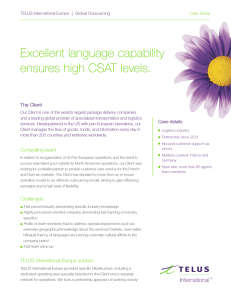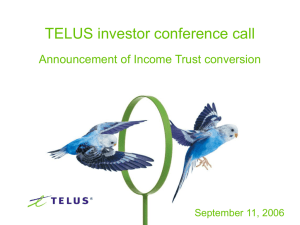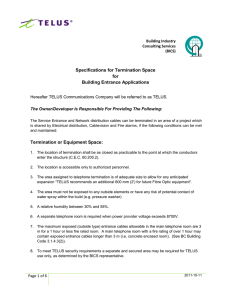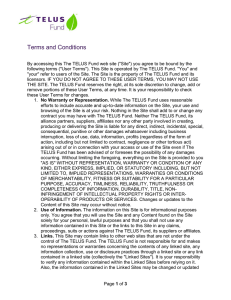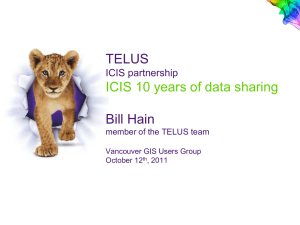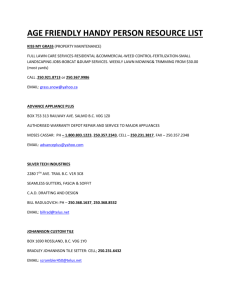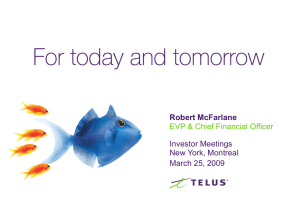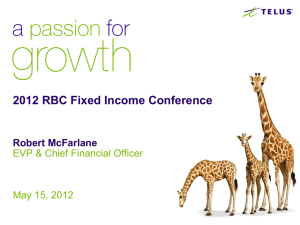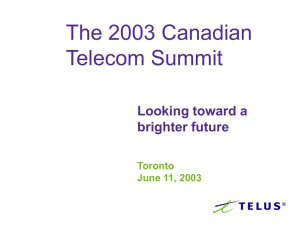Skanska Brevmall - 7×24 Exchange International
advertisement
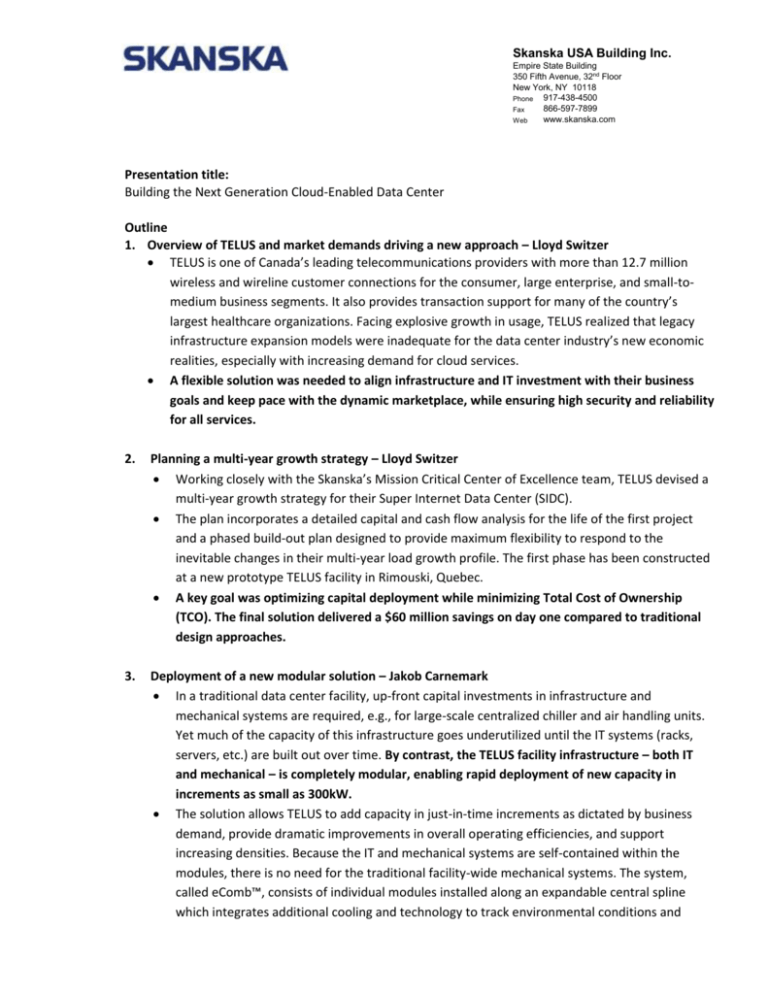
Skanska USA Building Inc. Empire State Building 350 Fifth Avenue, 32nd Floor New York, NY 10118 Phone 917-438-4500 866-597-7899 Fax www.skanska.com Web Presentation title: Building the Next Generation Cloud-Enabled Data Center Outline 1. Overview of TELUS and market demands driving a new approach – Lloyd Switzer TELUS is one of Canada’s leading telecommunications providers with more than 12.7 million wireless and wireline customer connections for the consumer, large enterprise, and small-tomedium business segments. It also provides transaction support for many of the country’s largest healthcare organizations. Facing explosive growth in usage, TELUS realized that legacy infrastructure expansion models were inadequate for the data center industry’s new economic realities, especially with increasing demand for cloud services. A flexible solution was needed to align infrastructure and IT investment with their business goals and keep pace with the dynamic marketplace, while ensuring high security and reliability for all services. 2. Planning a multi-year growth strategy – Lloyd Switzer Working closely with the Skanska’s Mission Critical Center of Excellence team, TELUS devised a multi-year growth strategy for their Super Internet Data Center (SIDC). The plan incorporates a detailed capital and cash flow analysis for the life of the first project and a phased build-out plan designed to provide maximum flexibility to respond to the inevitable changes in their multi-year load growth profile. The first phase has been constructed at a new prototype TELUS facility in Rimouski, Quebec. A key goal was optimizing capital deployment while minimizing Total Cost of Ownership (TCO). The final solution delivered a $60 million savings on day one compared to traditional design approaches. 3. Deployment of a new modular solution – Jakob Carnemark In a traditional data center facility, up-front capital investments in infrastructure and mechanical systems are required, e.g., for large-scale centralized chiller and air handling units. Yet much of the capacity of this infrastructure goes underutilized until the IT systems (racks, servers, etc.) are built out over time. By contrast, the TELUS facility infrastructure – both IT and mechanical – is completely modular, enabling rapid deployment of new capacity in increments as small as 300kW. The solution allows TELUS to add capacity in just-in-time increments as dictated by business demand, provide dramatic improvements in overall operating efficiencies, and support increasing densities. Because the IT and mechanical systems are self-contained within the modules, there is no need for the traditional facility-wide mechanical systems. The system, called eComb™, consists of individual modules installed along an expandable central spline which integrates additional cooling and technology to track environmental conditions and Page 2 of 2 optimize energy efficiency. As the facility expands to meet TELUS’ growing needs, the spline is extended in each phase and the next module or set of modules is added to the facility. The TELUS supply chain strategy integrates server and LAN vendors, further increasing efficiency in operations and deployment. All of the eComb components are manufactured to TELUS specifications with just a 16-week lead time, allowing the company to respond quickly to changing business needs and anticipated customer demands. The modules are also designed with the flexibility to change over time, adapting to and incorporating the benefits of evolving technology during the facility’s lifetime. This on-demand build strategy allows TELUS to continue refining individual module configuration to take advantage of the best in evolving technologies and any “density sweet spot” for all project phases. 4. Operations and maintenance strategies – Jakob Carnemark TELUS also incorporated advanced DCIP (Data Center Intelligence Platform) which combines traditional construction, building management, operations and IT tools with sophisticated data tracking and analysis capabilities that integrate all of the relevant IT system, energy usage, mechanical, finance, risk, external environment and operating data into one user-friendly dashboard. The DCIP encompasses as-built engineering characteristics and control parameters for visibility and optimal performance, enabling TELUS to optimize energy use, IT performance, operating and maintenance activities across the enterprise and manage key cost drivers. 5. Measurable results – Lloyd Switzer As a result of all these innovative technologies and strategies, the Skanska modular systems deployed at TELUS are more energy efficient, with a proven average Power Usage Effectiveness (PUE) of just 1.15 (compared to industry averages of 1.6 to 2.0), and they reduce water usage by 80 percent, supporting TELUS’ strategies for environmental sustainability. Additionally, there is no need for batteries, eliminating any ecological impact from battery disposal. While the level of flexibility and incremental scalability of the modular solution now in use at TELUS can provide a cost-effective approach for any sector of the data center industry, the benefits of this solution are particularly relevant for cloud services providers. To supply the seamless, unlimited, on-demand cloud experience that customers expect, it is all too easy for cloud providers to overinvest and overbuild. Ultimately, Total Cost of Ownership TCO is lowered by reducing up-front investment, eliminating maintenance costs on overbuilt equipment and systems, and increasing efficiency in energy and operating costs over time. The modular solution allows TELUS to keep its infrastructure and cost footprint at a minimum during each phase of growth, yet respond rapidly to changes in anticipated utilization as cloud demand continues to shift. By forecasting just 16 weeks in advance, the integrated TELUS solution aligns data center infrastructure with the speed of the business and the dynamic pace of the cloud marketplace.
